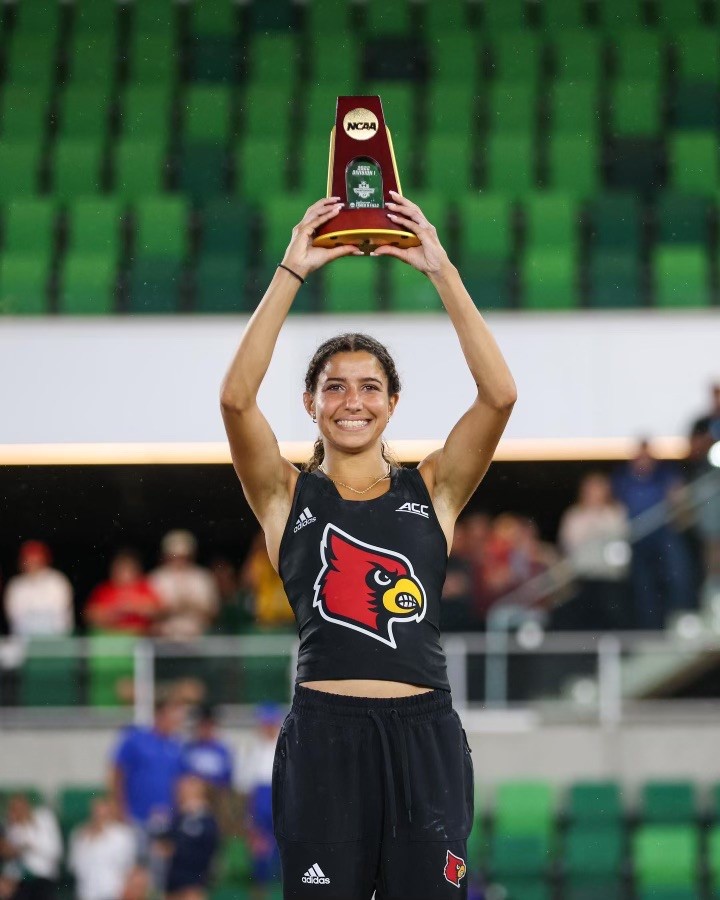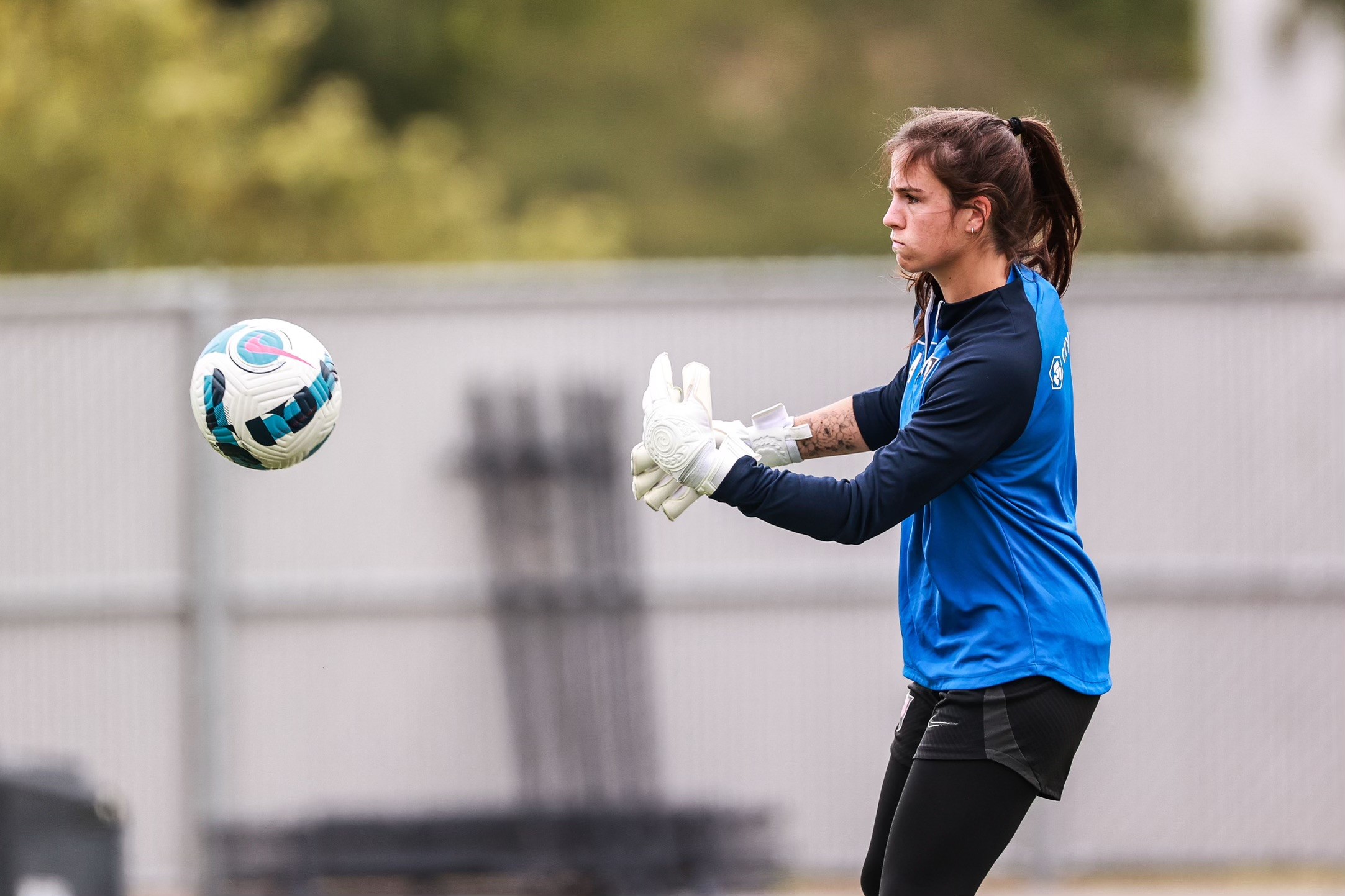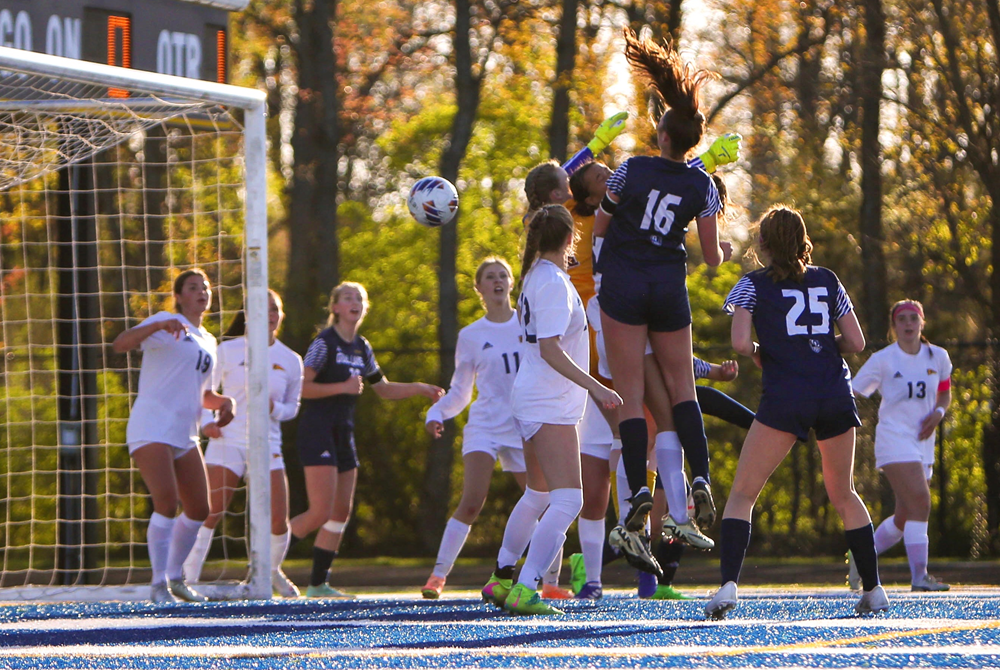
East Kentwood Friends Continuing to Excel as NCAA Champ, Pro Soccer Keeper
By
Steve Vedder
Special for MHSAA.com
August 8, 2022
Maia Perez and Gabriela Leon saw it coming.
In fact, the two 2017 East Kentwood all-staters each predicted remarkable post-high school success for each other long before graduation.
Perez was a four-year letterwinner as a soccer goalkeeper who led the Falcons to the Division 1 Semifinals as a sophomore and now plays professionally in Los Angeles. Leon, an all-state pole vaulter in high school, recently became University of Louisville's first NCAA champion in that event.
The two say the success doesn't come as a surprise to either, that part of that success can be explained because they continually pushed each other athletically at East Kentwood.
"Obviously there are a lot of good athletes at East Kentwood, and she was one of those amazing athletes," Perez said of Leon. "When she accomplished something, I wanted to do something big, too. I was all-state in soccer, she was all-state in track, and it was nice to have someone push you, even on days when you didn't feel like being pushed."
Leon credits Perez for helping her grasp the difference between toiling as an ordinary athlete and rising to an elite status as early as the ninth grade.
"When you see high-caliber athletes in the state finals, I think you see the struggles that others don't see," Leon said. "I saw what she was doing, and I learned from that. I learned, and I think she did too, that you have to work hard to be good, to achieve your goals. There is definitely mutual respect between us."
 The two met as freshmen and quickly became friends. They originally had soccer in common as both played junior varsity as freshmen before Perez was promoted to varsity later that spring. The teammates began hanging out together off the field, be it at the beach or while taking the school's advanced physical education class together. By the time they were sophomores, however, it had become apparent that Perez's future – despite being a good basketball player – would remain in soccer, while Leon – who had also lettered in volleyball and cross country – narrowed her focus to track.
The two met as freshmen and quickly became friends. They originally had soccer in common as both played junior varsity as freshmen before Perez was promoted to varsity later that spring. The teammates began hanging out together off the field, be it at the beach or while taking the school's advanced physical education class together. By the time they were sophomores, however, it had become apparent that Perez's future – despite being a good basketball player – would remain in soccer, while Leon – who had also lettered in volleyball and cross country – narrowed her focus to track.
Both excelled after leaving East Kentwood. Leon had earned her first top-eight MHSAA Finals places as a sophomore, and as a senior placed fourth in pole vault, third in long jump and ran on the fourth-place 400 relay and third-place 1,600 relay as East Kentwood finished third in Lower Peninsula Division 1. Her high school personal records were 13 feet in pole vault and 18-11 in long jump (with a wind-aided 19-7). She broke Louisville's indoor and outdoor records in the pole vault as a sophomore and never looked back. She won the 2022 NCAA outdoor championship in June with a jump of 15-feet, one inch (4.6 meters) while becoming just the fourth collegian ever to amass three clearances over 4.6 meters.
Perez was a three-time Ottawa-Kent Conference Red soccer pick in high school who helped the Falcons in 2015 to their best postseason finish, when they lost to 1-0 in a Semifinal to eventual Division 1 champ Saline. She went on to play at University of Hartford after attracting interest from other programs including Western Michigan, Coastal Carolina and Pittsburgh. She wound up playing every minute of all 37 of her starts as a sophomore and junior while missing just 45 minutes over 19 games as a freshman. COVID-19 wiped out the program's season when Perez was a senior. Still, she is eighth on the school's all-time saves list with 206 while ranking 10th in shutouts with 12.
Following college, Perez was signed by the Los Angeles-based Angel City FC of the National Women’s Soccer League. While she wasn't drafted by any NWSL club, Perez impressed coaches enough during a tryout to land a spot on the team's "Discovery List" as the youngest of three goalkeepers.
"Things have been going real well for me there," Perez said. "I feel like I've improved a ton."
While Perez credits Leon with pushing her as an athlete, she said the two didn't necessarily dwell on what they accomplished in high school. They did, however, compare notes on the similarities it took for both to succeed, both physically and mentally.
"We didn't necessarily talk about (honors) a lot," Perez said. "We both knew what each other accomplished, and I don't think we need to talk about it. But I just knew one day she would be really good in track."
 Leon said the trait which stuck out about Perez in high school was her competitive drive. She hated to lose, Leon said.
Leon said the trait which stuck out about Perez in high school was her competitive drive. She hated to lose, Leon said.
"She was always a very impressive athlete," Leon noted. "She always had (success) in her because she was a real hard worker. Going into high school you could see her work ethic. We had a mutual friendship, and I saw what a work ethic and being humble could do for you."
As for herself, Leon, like many athletes, explored playing many sports. But she always came back to track.
"I always wanted to be the best athlete I could be," she said. "I was never just satisfied with just doing something. I always had this deep desire to perform to the best of my ability."
Perez remembers the first sport which interested her was skateboarding. In fact, the first time Perez met then-East Kentwood coach John Conlon, she told him she was only marginally interested in soccer. Conlon, who led East Kentwood’s girls and boys programs to a combined 654 wins and the boys varsity to five Division 1 championships, quickly made a convert of Perez.
"It's funny how things work out," Perez said. "I was looking for something that I could really be a part of, and now it's my job and I'm so happy I can say I'm getting paid for something I really like."
2021-22 Made in Michigan
Aug. 3: 3-Time Finals Champ Cherishes Memories, Considering Golf Future - Read
Aug. 1: Lessons Learned on Track Have Jibowu's Business Surging to Quick Success - Read
July 28: Running Set Life's Stage for Grosse Pointe South's Record-Setting Meier Sisters - Read
July 25: 2005 Miss Basketball DeHaan Cherishing Newest Title: 1st-Time Mom - Read
July 21: Championship Memories Still Resonate with St. Thomas Star Lillard - Read
July 14: Portage Central Champ Rolls to Vanderbilt, Writing Next Chapter in Alabama - Read
July 12: Coaching Couple Passing On Knowledge, Providing Opportunities for Frankfort Wrestlers - Read
June 30: Hrynewich's Star Continuing to Rise with Olympic, Pro Sports Arrivals - Read
PHOTOS (Top) Clockwise from left, Gabriela Leon competes for the East Kentwood and University of Louisville track & field teams, and Maia Perez plays soccer for East Kentwood and trains for the NWSL's Angel City FC. (Middle) Leon holds up her NCAA championship trophy in June. (Below) Perez is one of three keepers for Angel City FC. [Photos courtesy of East Kentwood's athletic department (2017 soccer), Run Michigan (2017 track & field), the Louisville athletic department (2022 track & field) and Will Navarro/Angel City FC (2022 soccer).]

Performance of the Week: Richland Gull Lake's Lilah Smith
May 2, 2024
 Lilah Smith ♦ Richland Gull Lake
Lilah Smith ♦ Richland Gull Lake
Junior ♦ Soccer
Smith scored both goals as Gull Lake defeated Portage Central 2-1 on April 24. Gull Lake was ranked No. 2 in Division 2 at the time (now No. 3), and Portage Central remains No. 3 in Division 1 after suffering its lone loss this season to the Blue Devils, who have since improved to 8-1-2 overall this spring.
After earning all-state honorable mention as a freshman and making the second team as a sophomore, Smith moved from center back to midfield this season, first in more of an attacking role and now as a defensive mid. Standing 6 feet tall, her first goal against Central was a header off a corner kick, and the game-winner came on a second-half penalty shot. She plays basketball as well and is committed to continue playing soccer collegiately at Toledo.
@mhsaasports ⚽️POW: Lilah Smith #soccer #gulllake #letsgo #goal #part1 #highschoolsports #tiktalk #interview #performanceoftheweek #mistudentaid #fyp #MHSAA ♬ original sound - MHSAA
@mhsaasports ⚽️POW: Lilah Smith #tiktalk #questiontime #part2 #parenttrap #drake #fire #pineapple #greysanatomy #performanceoftheweek #mistudentaid #fyp #MHSAA ♬ original sound - MHSAA
Follow the MHSAA on TikTok.
MHSAA.com's "Performance of the Week" features are powered by MI Student Aid, a division within the Department of Lifelong Education, Advancement, and Potential (MiLEAP). MI Student Aid encourages students to pursue postsecondary education by providing access to student financial resources and information. MI Student Aid administers the state’s 529 college savings programs (MET/MESP), as well as scholarship and grant programs that help make college Accessible, Affordable and Attainable for you. Connect with MI Student Aid at www.michigan.gov/mistudentaid and find more information on Facebook and Twitter @mistudentaid.
Past 2023-24 Honorees
April 25: Mason Mayne, Lawton track & field - Report
April 18: Alli Wright, Jenison softball - Report
April 11: Chloe Wishart, Trenton soccer - Report
March 28: Jenna Maki, Ishpeming basketball - Report
March 22: Jaremiah Palmer, Niles Brandywine basketball - Report
March 15: Leah Hodge, North Farmington gymnastics - Report
March 8: Darius Marines, Detroit Catholic Central wrestling - Report
March 1: Rylee Smith, Zeeland West bowling - Report
Feb. 22: Caleb Lewandowski, Traverse City West skiing - Report
Feb. 15: Jadin Mix, Onaway basketball - Report
Feb. 8: Onalee Wallis, Cadillac skiing - Report
Feb. 1: Abbey DeGraw, Rochester Hills Stoney Creek competitive cheer - Report
Jan. 25: Ewan Todd, Riverview swimming - Report
Jan. 18: Ashley Weller, Jackson Northwest basketball - Report
Jan. 11: Michael Baldwin, Saginaw Arthur Hill wrestling - Report
Dec. 15: Jena Fijolek, Fenton bowling - Report
Dec. 8: Sophia Wagner, Escanaba gymnastics - Report
Dec. 1: Isaiah Marshall, Southfield Arts & Technology football - Report
Nov. 24: Sarah Bradley, Clarkston Everest Collegiate volleyball - Report
Nov. 17: Kalieb Osborne, Waterford Mott football - Report
Nov. 10: Tekalegn Vlasma, Muskegon Western Michigan Christian soccer - Report
Nov. 3: Colton Kinnie, Birmingham Seaholm football - Report
Oct. 27: Lauren Timpf, Macomb Lutheran North golf - Report
Oct. 20: Alena Li, Okemos golf - Report
Oct. 13: Seth Norder, Grand Haven cross country - Report
Oct. 5: Paige Anderson, Muskegon Reeths-Puffer golf - Report
Sept. 29: MacKenzie Bisballe, Lake City volleyball - Report
Sept. 22: Jhace Massey, Gladwin football - Report
Sept. 15: Kaylee Draper, Sturgis swimming - Report
Sept. 8: Owen Jackson, Traverse City St. Francis tennis - Report
Sept. 1: Rachel Forsyth, Ann Arbor Pioneer cross country - Report
PHOTO Gull Lake's Lilah Smith (16) rises above the defense to connect on a header against Portage Central. (Action photo by Cindy Corstange/The Open Shutter Photography; headshot by Alan Gawel/Main Street Portraits.)

